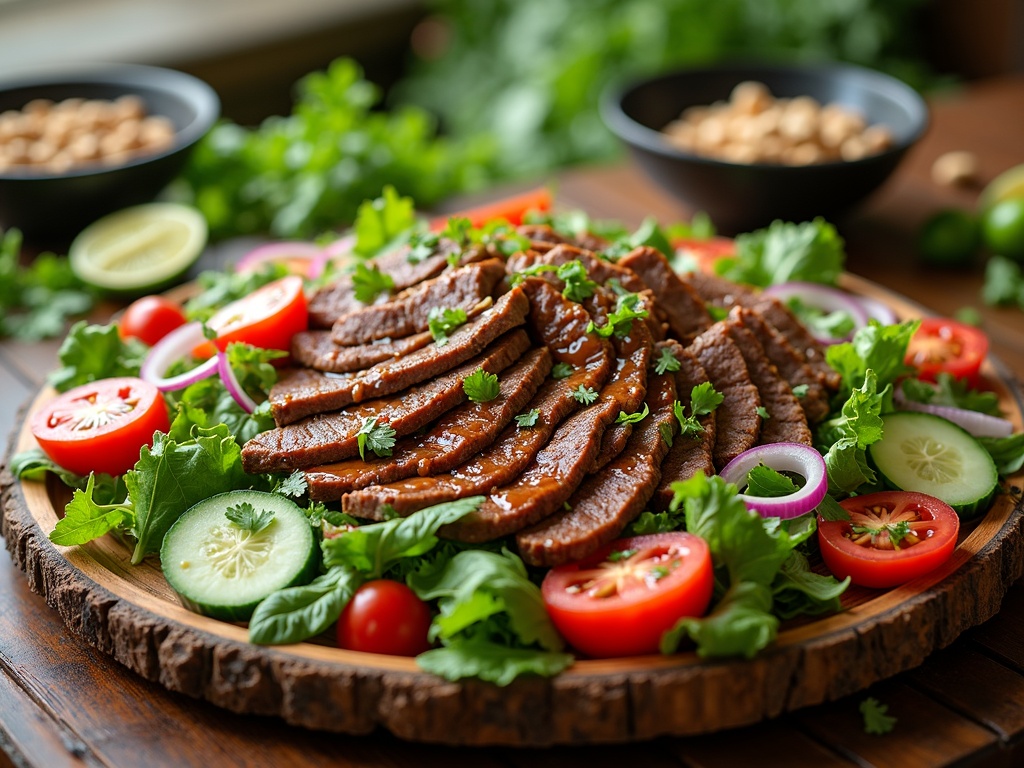Thai beef salad, traditionally known as “Yum Nua,” captivates diners with its perfect balance of spicy, sour, salty, and sweet flavors while offering impressive nutritional benefits. This vibrant dish combines tender sliced beef with fresh herbs and vegetables, all brought together by a punchy dressing that showcases the core philosophy of Thai cuisine.
Find In This Article
Key Takeaways
- Thai beef salad delivers approximately 25g of protein per serving while remaining moderate in calories (250-400 per serving).
- The dish achieves its distinctive flavor profile through the careful balance of lime juice, fish sauce, chili, and palm sugar.
- Premium beef preparation is crucial – cooking to medium-rare and slicing thinly against the grain ensures tenderness.
- The recipe is highly adaptable for dietary needs, including gluten-free, low-carb, and even plant-based variations.
- Fresh herbs like mint, cilantro, and Thai basil are essential components that provide the authentic aroma and freshness.
What Makes Thai Beef Salad Special
Thai beef salad, traditionally known as “Yum Nua,” stands out among Asian dishes for its incredible flavor profile and nutritional benefits. I’ve found that what truly sets this dish apart is its perfect balance of contrasting tastes that dance on your palate with each bite.
The magic of Thai beef salad lies in its harmonious blend of spicy, sour, salty, and sweet flavors. This balance isn’t accidental—it’s a cornerstone of Thai cooking philosophy. Fresh lime juice provides tanginess, fish sauce adds saltiness, chili brings heat, and a touch of palm sugar creates subtle sweetness. This combination creates a memorable taste experience that’s both refreshing and satisfying.
Nutritional Powerhouse
Beyond its flavor profile, Thai beef salad offers impressive nutritional benefits that make it popular among health-conscious eaters:
- High protein content (approximately 25g per serving) from thinly sliced beef
- Moderate calorie range between 250-400 calories per serving
- Naturally gluten-free when made with tamari instead of regular soy sauce
- Fresh vegetables provide fiber, vitamins, and minerals
- Minimal oil compared to many other beef dishes
This nutritional profile makes Thai beef salad an excellent choice for anyone following specific dietary plans, including low-carb or high-protein diets. The protein content supports muscle maintenance while the fresh vegetables deliver essential nutrients.
The popularity of Thai cuisine has grown substantially in recent years, with statistics showing a 20% increase in Thai restaurant visits between 2015-2020. This rising interest isn’t surprising given the cuisine’s focus on fresh ingredients and vibrant flavors.
I often pair my beef recipes with Thai-inspired elements to create fusion dishes that bring these beloved flavors to different contexts. The versatility of Thai beef salad also makes it pair wonderfully with other Asian dishes like crunchy Asian slaw or a classic Pad Thai for a complete meal.
For a lighter meal option, you might consider complementing your Thai beef salad with a simple rice salad or adding more variety with additional healthy salad options on the side. The flexibility of this dish makes it suitable for everything from casual weeknight dinners to impressive entertaining.
Essential Ingredients for the Perfect Thai Beef Salad
The secret to a truly remarkable Thai beef salad lies in using the freshest, highest-quality ingredients. I’ve found that this colorful dish balances savory, spicy, and tangy flavors in a way that few other recipes can match.
Core Components That Make This Dish Shine
Premium beef makes all the difference in this recipe. I prefer using sirloin or flank steak, grilled to medium-rare and sliced thinly against the grain. This cutting technique ensures each bite remains tender and easily absorbs the vibrant dressing. The beef provides a rich, satisfying base that carries the brighter flavors of the other ingredients.
Fresh herbs are non-negotiable for authentic flavor. I always add generous amounts of mint and cilantro, which contribute that distinctive Thai aroma and freshness. These herbs don’t just garnish the dish – they’re integral to its character and help cut through the richness of the beef.
For the crisp vegetable element, I include cucumbers, tomatoes, and thinly sliced red onions. These vegetables add refreshing crunch, juiciness, and subtle sweetness that balances the savory meat. You might also consider adding Asian slaw components for extra texture and flavor complexity.
The dressing is where the magic happens in Thai beef salad. The key components include:
- Fish sauce for umami depth
- Fresh lime juice for brightness
- A touch of sugar to balance the acidity
- Thai bird’s eye chilies for heat
Getting the proportions right makes all the difference. I use 2 tablespoons of fish sauce, 2 tablespoons of fresh lime juice, and 1 tablespoon of sugar as the foundation. This creates the perfect balance between salty, sour, and sweet notes that defines Thai cuisine.
For those counting macros, a typical serving contains approximately 10g of fat and 12g of carbohydrates, making it a relatively light yet satisfying meal option. The protein content from the beef makes it filling without being heavy.
If you’re looking to expand your Thai-inspired menu, consider pairing this salad with beef teriyaki or pad Thai for a complete feast.
For a lighter meal, you might serve this alongside a rice salad which complements the bold flavors perfectly. The rice helps temper the heat while adding a pleasant textural contrast.
This salad also fits beautifully into a spread of healthy salad recipes for a nutritious dinner party menu. Its bold colors and flavors make it a standout among more traditional green salad recipes.
I’ve found that preparing the dressing ahead of time and letting it sit for 30 minutes allows the flavors to meld together more completely. When you’re ready to serve, simply toss everything together at the last moment to maintain the perfect texture – crisp vegetables, tender beef, and that aromatic, punchy dressing that makes Thai beef salad so irresistible.
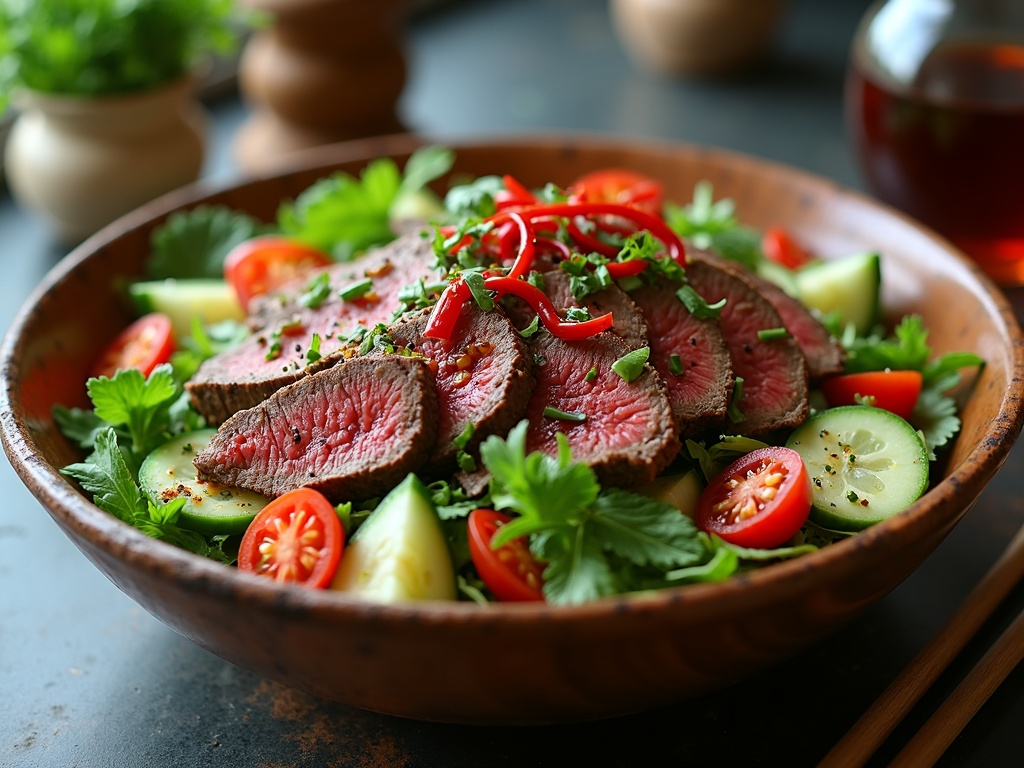
Creating Your Thai Beef Salad
Beef Preparation: The Heart of the Dish
I’ve found that the secret to a spectacular Thai beef salad starts with perfectly cooked meat. For optimal tenderness, I sear my steak in a scorching hot cast-iron skillet for 3-4 minutes per side to achieve a medium-rare finish. The intense heat creates a flavorful crust while keeping the inside juicy.
After cooking, resting the beef for at least 5 minutes is crucial – this allows the juices to redistribute throughout the meat, ensuring every bite remains moist and flavorful. When it’s time to slice, I always cut against the grain in thin strips approximately ¼ inch thick. This technique breaks up the muscle fibers, resulting in beef that’s much easier to chew and practically melts in your mouth.
For a variation on this preparation, you might also enjoy trying my beef teriyaki which uses similar slicing techniques but with a Japanese flavor profile.
The vegetables require thoughtful preparation too. I julienne cucumbers and carrots into matchstick sizes for quick marinade absorption and textural contrast. For onions, I slice them paper-thin and soak in cold water for 10 minutes to remove some of their sharpness while maintaining their crisp texture. Fresh herbs like mint, cilantro, and Thai basil should be torn rather than chopped to release their aromatic oils without bruising.
Balancing Flavors and Assembly
The dressing is where authentic Thai flavors truly shine. I combine lime juice, fish sauce, a touch of palm sugar, and minced garlic in a small bowl, whisking vigorously until the sugar dissolves completely. For heat, I add thinly sliced bird’s eye chilies, adjusting the amount based on my spice tolerance.
To achieve that signature Thai flavor balance, I follow the fundamental combination of sour, salty, sweet, and spicy elements:
- Sour: Fresh lime juice provides brightness and helps tenderize the beef
- Salty: Fish sauce delivers that umami depth impossible to replicate
- Sweet: Palm sugar (or brown sugar) balances the acidity and heat
- Spicy: Fresh chilies add that characteristic Thai heat that builds gradually
The assembly sequence makes a difference in the final presentation and flavor. I start with a base of mixed greens or green salad varieties on a large serving platter. Next comes a layer of sliced vegetables and herbs, followed by the sliced beef arranged artfully on top. Just before serving, I drizzle the dressing over everything and finish with a sprinkle of crushed peanuts and fresh herbs.
For added texture and flavor variety, I sometimes include components from my Asian slaw recipe, which complements the beef perfectly.
To keep everything at maximum freshness, I avoid dressing the salad until right before serving. This prevents the greens from wilting and maintains the crisp textures that make Thai beef salad so satisfying. For a complete meal, I sometimes serve this alongside a simple rice salad for a more substantial dinner option.
The versatility of this dish makes it perfect for hot summer days or as a light dinner option. The bright flavors and nutritional balance also place it firmly in the category of healthy salad recipes without sacrificing an ounce of taste. For another Thai-inspired option with similar flavor profiles but different textures, you might also enjoy my Pad Thai recipe as an alternative.
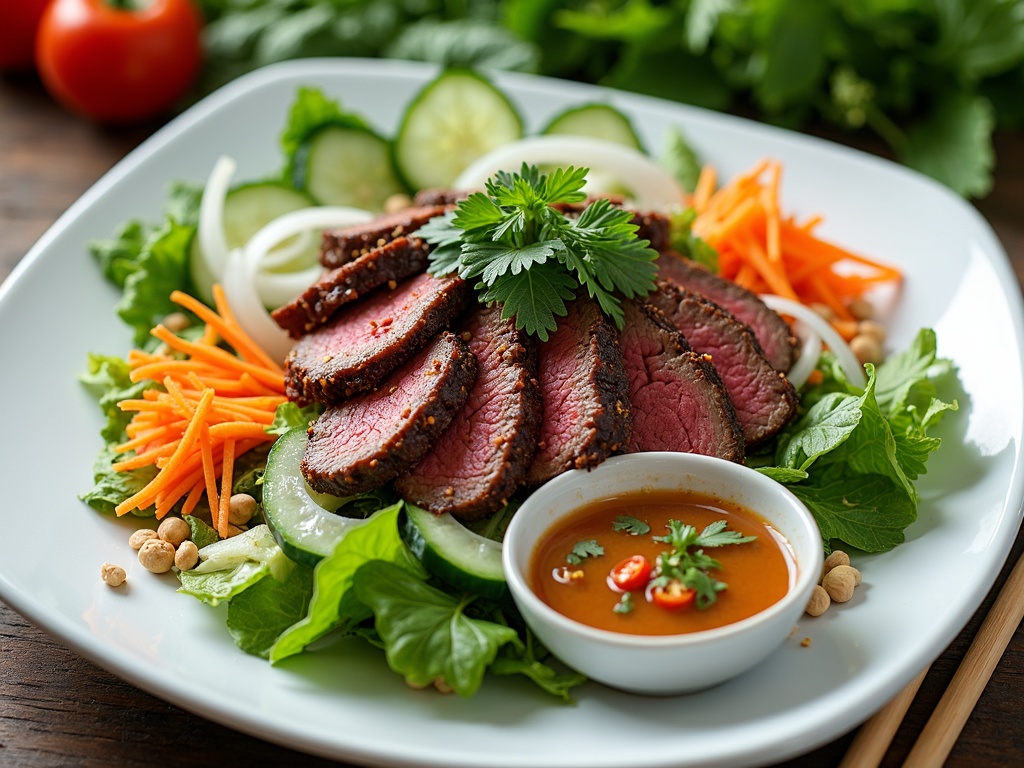
Modern Takes and Variations
Thai beef salad has evolved beyond its traditional roots, with exciting adaptations that cater to different tastes and dietary preferences. I’ve experimented with numerous variations that maintain the essence of this vibrant dish while introducing new elements.
Regional and Dietary Adaptations
Regional adaptations have given this classic dish new dimensions. In Western interpretations, I’ve noticed additions like roasted peanuts sprinkled on top, creating a delightful crunch that complements the tender beef strips perfectly. This textural contrast elevates the dish to new heights.
For those with dietary restrictions or preferences, protein alternatives work surprisingly well:
- Grilled chicken breast, thinly sliced, offers a lighter option while maintaining protein content
- Firm tofu, marinated in the same flavorful blend as the beef, creates a satisfying vegan base
- Grilled shrimp adds a seafood twist that pairs beautifully with the lime-based dressing
I’ve found that a healthy salad recipe approach can transform this traditionally meat-focused dish into something entirely plant-based. Vegan-friendly dressing substitutions might include coconut aminos instead of fish sauce and maple syrup or agave nectar replacing palm sugar.
Fusion Interpretations
Contemporary chefs have created exciting fusion versions that blend Thai flavors with other culinary traditions. I’ve tried combining Thai beef salad elements with Mediterranean ingredients – think feta cheese and olives alongside the traditional herbs for a Greek-Thai fusion that’s unexpectedly harmonious.
The base rice salad version incorporates jasmine or brown rice for a more substantial meal. Some creative interpretations include quinoa or cauliflower rice for grain-free options that still provide satisfying texture.
Adding inspiration from other Asian cuisines has resulted in delicious variations. Korean gochujang can replace some of the chili for a deeper, smokier heat, while Japanese ponzu brings a citrusy brightness to the Asian slaw profile.
For a complete meal with less meat content, I sometimes incorporate more green salad components like avocado slices or mango chunks for creamy richness and tropical sweetness. These additions complement the zingy dressing beautifully.
The versatility of Thai beef salad extends to its presentation as well – from traditional family-style serving to modern pad Thai-inspired individual portions wrapped in lettuce leaves for a fun, interactive dining experience.
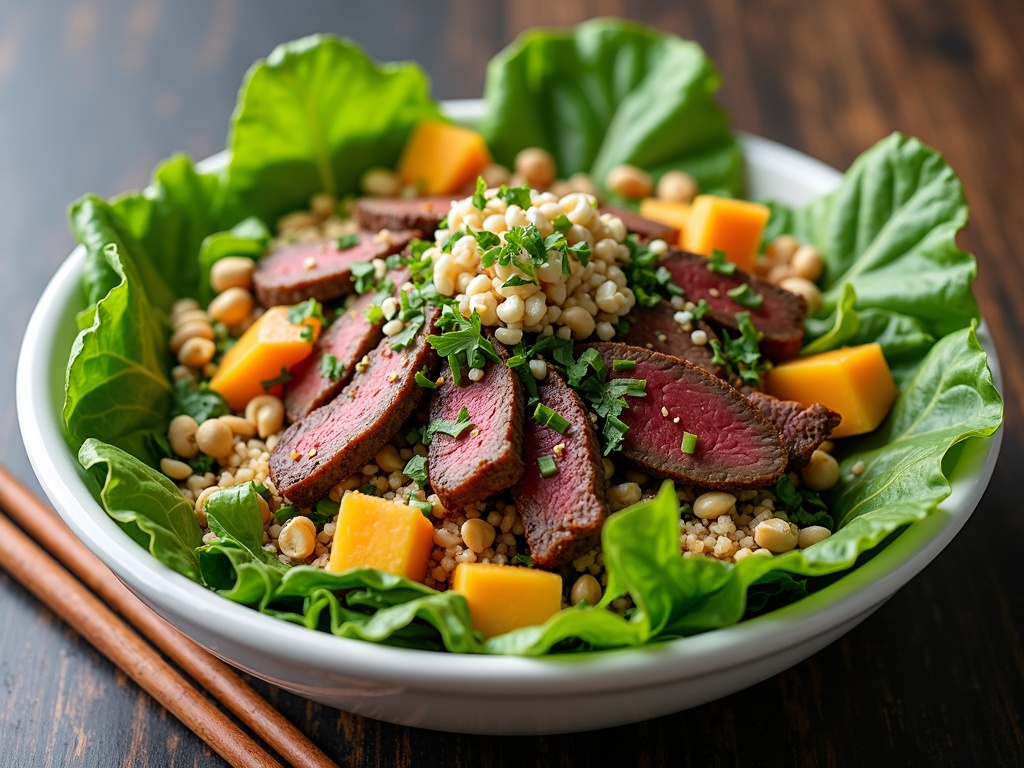
Health Benefits and Dietary Considerations
Thai beef salad isn’t just a tasty dish—it’s packed with impressive nutritional benefits that make it a smart choice for health-conscious eaters. I’ve found this dish particularly valuable as part of a balanced diet because it combines protein, vegetables, and flavorful herbs in one satisfying meal.
Nutritional Powerhouse
The lean beef in this dish delivers a significant protein punch, providing essential amino acids needed for muscle repair and maintenance. A typical serving contains approximately 20-25 grams of protein, making it an excellent option for active individuals or anyone looking to maintain muscle mass. This protein content also helps create a feeling of fullness that lasts longer than carbohydrate-heavy meals.
What makes Thai beef recipes stand out is their relatively low carbohydrate profile. By focusing on fresh vegetables rather than starchy fillers, the dish naturally supports weight management goals while still delivering satisfaction. The abundance of fresh vegetables also means you’re getting a wealth of vitamins, minerals, and fiber in every bite.
For those with specific dietary concerns, Thai beef salad offers several advantages:
- Naturally gluten-free when prepared with tamari instead of regular soy sauce
- Easily adaptable for low-carb or keto diets by adjusting the sugar content
- Can be modified for paleo diets by using compliant dressing ingredients
- Dairy-free in its traditional form
I can easily adjust the spice levels to suit different preferences without sacrificing flavor. For milder palates, reducing the amount of chili or substituting with milder varieties creates a gentler heat profile. Conversely, adding extra chilies or including their seeds intensifies the spiciness for those who enjoy more heat.
The fresh herbs and vegetables in Thai beef salad, like those found in many healthy salad recipes, deliver antioxidants and anti-inflammatory compounds. Ingredients such as cilantro, mint, and lime not only contribute to the distinctive Thai flavor profile but also offer health-promoting properties.
For a complete meal, I sometimes pair this salad with a side of rice salad or Asian slaw for additional vegetables and complex carbohydrates. The versatility of the dish allows for endless variations, making it easy to keep meals interesting while maintaining nutritional value.
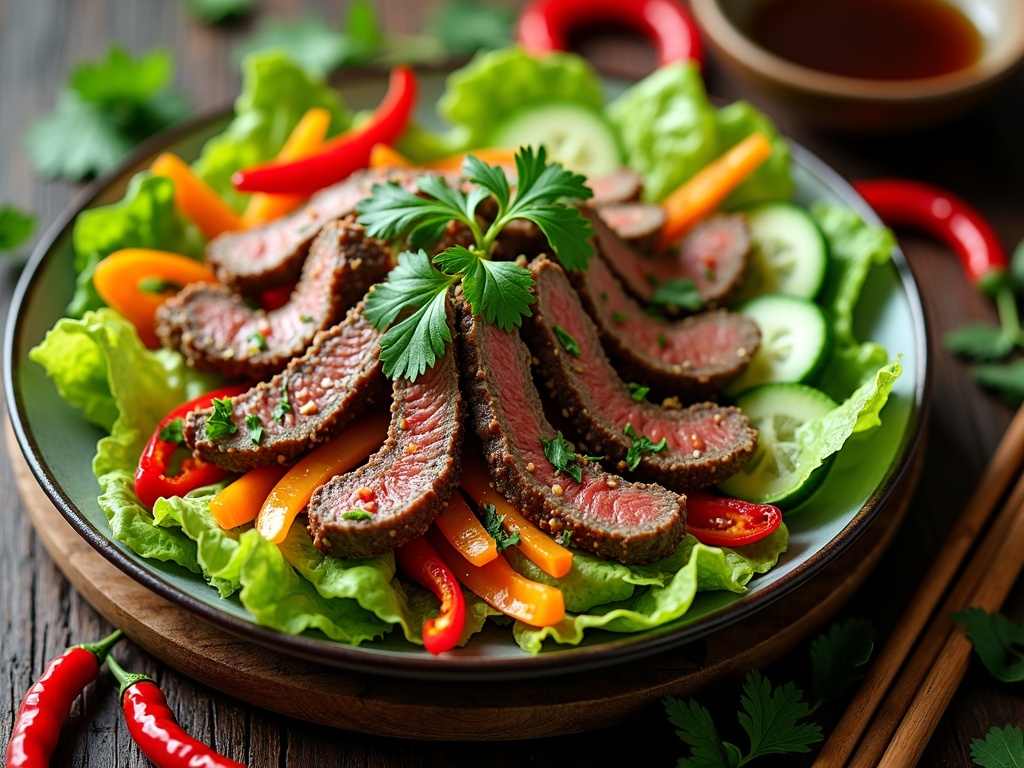
Sources:
Food Network, Healthline, The National Restaurant Association

